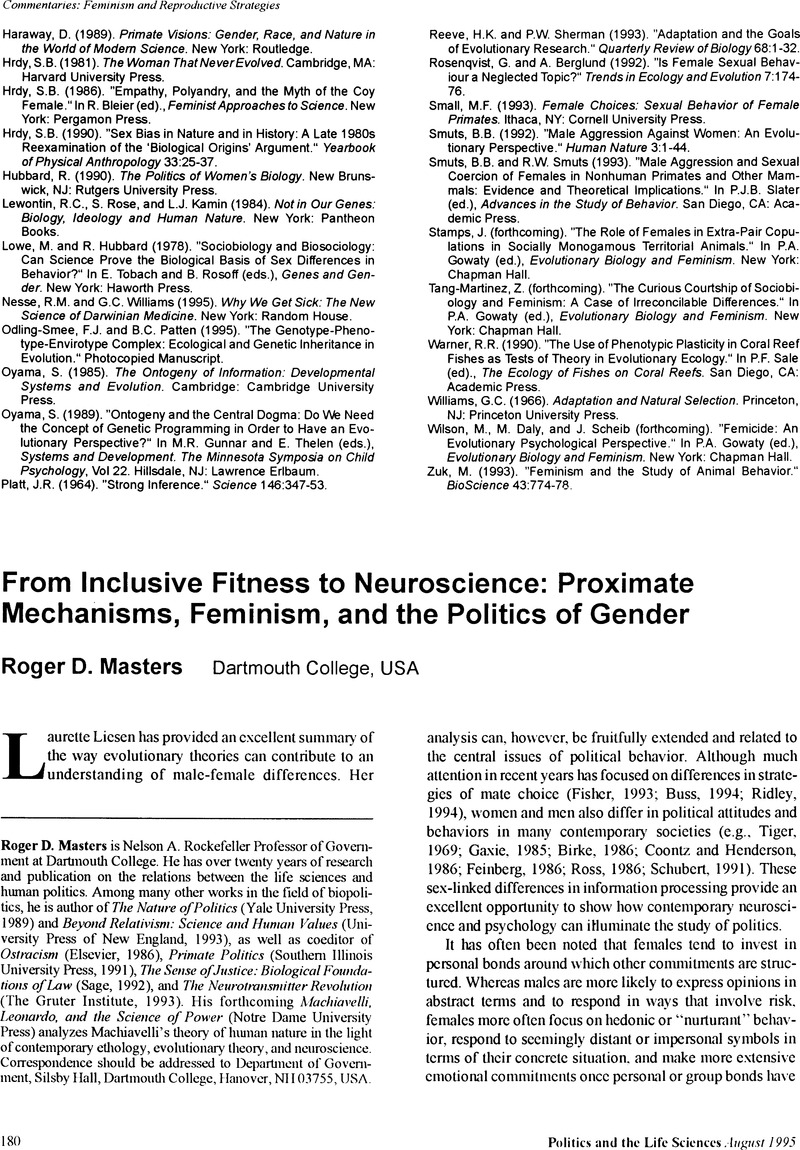No CrossRef data available.
Article contents
From Inclusive Fitness to Neuroscience: Proximate Mechanisms, Feminism, and the Politics of Gender
Published online by Cambridge University Press: 17 May 2016
Abstract
An abstract is not available for this content so a preview has been provided. Please use the Get access link above for information on how to access this content.

- Type
- Roundtable Commentaries
- Information
- Copyright
- Copyright © Association for Politics and the Life Sciences
References
Babchuck, W.A., Hames, R.B., and Thomason, R.A.(1985). “Sex Differences in the Recognition of Infant Facial Expressions of Emotion: The Primary Caretaker Hypothesis.” Ethology and Sociobiology 6:89–102.CrossRefGoogle Scholar
Barchas, P.R., Crissman, S.J., Ford, J.B., and Wilkes, C.D.(1984). “Social Agreements, Disagreements and Relative Hemispheric Activity.” In Barchas, P.R. and Mendoza, S.P.(eds.), Social Cohesion: Essays Toward a Sociophysiological Perspective. Westport, CT: Greenwood.Google Scholar
Benbow, C.P.(1988). “Sex Differences in Mathematical Reasoning Ability in Intellectually Talented Preadolescents: Their Nature, Effects, and Possible Causes.” Behavioral and Brain Sciences 11:169–232.CrossRefGoogle Scholar
Birke, L.(1986). Women, Feminism, and Biology: The Feminist Challenge. New York: Methuen.Google Scholar
Buss, D.(1995). “Psychological Sex Differences.” American Psychologist 50:164–68.Google ScholarPubMed
Carroll, S. and Strimling, W.S.(1983). Women's Routes to Elective Office: A Comparison with Men's. New Brunswick, NJ: Center for the American Woman and Politics, Rutgers—The State University of New Jersey.Google Scholar
Coontz, S. and Henderson, P., eds. (1986). Women's Work, Men's Property: The Origins of Gender and Class. London: Verso.Google Scholar
Daly, M. and Wilson, M.(1978). Sex, Evolution, and Behavior. North Scituate, MA: Duxbury Press.Google Scholar
Darcy, R., Welch, S., and Clark, J.(1987). Women, Elections, and Representation. New York: Longman.Google Scholar
Ellis, L.(1986). “Evidence of Neuroandrogenic Etiology of Sex Roles from a Combined Analysis of Human, Nonhuman Primate and Nonprimate Mammalian Studies.” Personality and Individual Differences 7:519–52.CrossRefGoogle Scholar
Feinberg, R.(1986). “Market Economy and Changing Sex-Roles on a Polynesian Atoll.” Ethnololy 25:271–282.Google Scholar
Friedman, R.C., Richart, R.M., and Van de Wiele, R.L.(1974). Sex Differences in Behavior. New York: Wiley.Google Scholar
Gaxie, P., ed. (1985). Explication du Vote. Paris: Presses de la Fondation Nationale des Sciences Politiques.Google Scholar
Hall, J.A.(1978). “Gender Effects in Decoding Nonverbal Cues.” Psychological Bulletin 85:845–57.CrossRefGoogle Scholar
Hall, J.A.(1987). “On Explaining Gender Differences: The Case of Nonverbal Communication.” In Shaver, P. and Hendrick, C.(eds.), Sex and Gender: Review of Personality and Social Psychology, Volume 7. Beverly Hills, CA: Sage.Google Scholar
Kirkcaldy, B.(1988). “Sex and Personality Differences in Occupational Interests.” Personality and Individual Differences 9:7–13.CrossRefGoogle Scholar
Kosslyn, S.M.(1988). “Aspects of Cognitive Neuroscience in Mental Imagery.” Science 240:1621–26.CrossRefGoogle Scholar
Masland, R.L.(1981). “Neurological Aspects of Dyslexia.” In Pavlidis, G.T. and Miles, T.R.(eds.), Dyslexia Research and Its Applications to Education. New York: Wiley.Google Scholar
Masters, R.D.(1989a). “Gender and Political Cognition.” Politics and the Life Sciences 8:3–39.CrossRefGoogle Scholar
Masters, R.D.(1989b). The Nature of Politics. New Haven, CT: Yale University Press.CrossRefGoogle Scholar
Masters, R.D. and Carlotti, S.J. Jr.(1994). “Gender Differences in Response to Political Leaders.” In Ellis, L.(ed.), Social Stratification and Socioeconomic Inequality. Volume 2. Westport, CT: Praeger.Google Scholar
Money, J. and Ehrhardt, A.A.(1972). Man and Woman, Boy and Girl: The Differentiation and Dimorphism of Gender Identity from Conception to Maturity. Baltimore, MD: Johns Hopkins University Press.Google Scholar
Poole, K.T. and Zeigler, L.H.(1985). Women, Public Opinion, and Politics: The Changing Political Attitudes of American Women. New York: Longman.Google Scholar
Reiter, R.R., ed. (1975). Toward an Anthropology of Women. New York: Monthly Review Press.Google Scholar
Rosenthal, R. and Rubin, D.B.(1982). “Further Meta-Analytic Procedures for Assessing Cognitive Gender Differences.” Journal of Educational Psychology 74:708–12.CrossRefGoogle Scholar
Ross, M.H.(1986). “Female Political Participation: A Cross-Cultural Explanation.” American Anthropologist 88:843–58.CrossRefGoogle Scholar
Shaver, P. and Hendrick, C., eds. (1987). Sex and Gender (Review of Personality and Social Psychology, Vol. 7). Beverly Hills, CA: Sage.Google Scholar
Steckler, N.A. and Rosenthal, R.(1985). “Sex Differences in Nonverbal and Verbal Communication with Bosses, Peers, and Subordinates.” Journal of Applied Psychology 70:157–63.CrossRefGoogle Scholar
Sullivan, D.G. and Masters, R.D.(1994). “Nonverbal Cues, Emotions, and Trait Attributions in the Evaluation of Political Leaders: The Contribution of Biopolitics to the Study of Media and Politics.” In Somit, A.O. and Peterson, S.(eds.), Research in Biopolitics. Volume II. Greenwich, CT: JAI Press.Google Scholar
Wittig, M. and Petersen, A., eds. (1979). Sex-Related Differences in Cognitive Functioning: Developmental Issues. New York: Academic Press.Google Scholar




